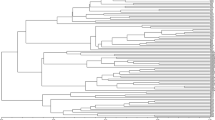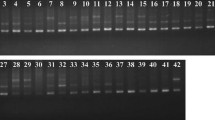Abstract
In this study, inter-simple sequence repeats (ISSR) ans simple sequence repeat (SSR) markers were used to investigate genetic diversity of 27 mulberry accessions including 19 cultivated accessions (six M. multicaulis, three M. alba, two M. atropurpurea, two M. bombycis, one M. australis, two M. rotundiloba, one M. alba var. pendula, one M. alba var. macrophylla, and one M. alba var. venose) and 8 wild accessions (two M. cathayana, two M. laevigata, two M. wittiorum, one M. nigra and one M. mongolica). ISSRs and SSRs were compared in terms of their informativeness and efficiency in a study of genetic diversity and relationships among 27 mulberry genotypes. SSRs presented a higher level of polymorphism and greater information content. All index values of genetic diversity both markers analyzed using Popgene 32 software indicated that within wild species had higher genetic diversity than within cultivated species. Cultivation may caused the lose of genetic diversity of mulberry compared with wild species revealed by ISSR and SSR markers. The mean genetic similarity coefficients among all mulberry genotypes ascribed by ISSR and SSR matrices were 0.7677 and 0.6131, respectively. For all markers a high similarity in dendrogram topologies was obtained although some differences were observed. Cluster analysis of ISSR and SSR using UPGMA method revealed that the wild species are genetically distant from the domesticated species studied here. The correlation coefficients of similarity were statistically significant for both marker systems used. Principal coordinates analysis (PCA) for ISSR and SSR data also supports their UPGMA clustering. These results have an important implication for mulberry germplasm characterization, improvement, molecular systematics and conservation.
Similar content being viewed by others
References
Aggarwal R.K., Udaykumar D., Hender P.S., Sarkar A. and Singh L. (2004). Isolation and characterization of six novel microsatellite markers for mulberry (Morns indica). Molecular Ecology Notes 4(3): 477–479
Awasthi A.K., Nagaraja G.M., Naik G.V., Thangavelu K., Nagaraju J. and Sriramana (2004). Genetic diversity and relationships in mulberry (genus Morus) as revealed by RAPD and ISSR marker assays. BMC Genetics 5: 1
Botstein D., White R.L., Skolnick M. and Davis R.W. (1980). Construction of a genetic linkage map in man using restriction fragment length polymorphisms. American Journal of Human Genetics 32: 314–331
Budak H., Pedraza F., Baenziger P.S., Cregan P.B. and Dweikat I. (2003). Development and utilization of SSR to estimate genetic diversity in a collection of pearl millet germplasm. Crop Science 43: 2284–2290
Connell J.P., Pammi S., Iqbal M.J., Huizinga T. and Reddy A.S. (1998). A high throughput procedure for capturing microsatellites from complex plant genomes. Plant Molecular Biology Reporter 16: 341–349
Dandin S.B. (1998). Mulberry a versatile biosource in the service of mankind. Acta Sericologic Sinica 24(2): 109–113
Doyle J.J. and Doyle J.L. (1987). A rapid DNA isolation procedure for small quantities of fresh leaf tissue. Phytochemical Bulletin 19: 11–15
Esha B. and Shirish A.R. (2001). Molecular distinction amongst varieties of Mulberry using RAPD and DAMD profiles. BMC Plant Biology 1: 3
Feng L.C., Yang G.W., Yu M.D., Ke Y.F. and Xiang Z.H. (1996). Studies on the genetic identities and relationships of mulberry cultivated species (Morus L.) via a random amplified polymorphic DNA assay. Acta Sericologic Sinica 22: 135–139
Gower J.C. (1966). Some distance properties of latent root and vector methods used in multivariate analysis. Biometrika 53: 325–338
Hard D.L. and Clark A.G. (1989). Principles of Population Genetics. Sinauer Associates, Sunderland, MA
He G.H., Meng R.H., Newman M., Gao G.Q., Pittman R.N. and Prakash C.S. (2003). Microsatellites as DNA markers in cultivated peanut. BMC Plant Biology 3(1): 3–11
Hirano H. (1982). Varietal differences of leaf protein profiles in mulberry. Phytochemistry 21: 1513–1518
Katsumata F. (1972). Relationship between the length of styles and the shape of idioplasts in mulberry leaves, with special reference to the classification of mulberry trees. Journal of Sericultural Science (Japan) 41: 387–395
Katsumata F. (1979). Chromosomes of Morus nigra L. from Java and hybridization affinity between this species and some mulberry species in Japan. Journal of Sericultural Science (Japan) 48: 418–422
Koidzumi G. (1917). Taxonomical discussion on Morus plants. Bulletin Imp. Sericultural Experiment Sta. (in Japanese) 3: 1–62
Milbourne D., Meyer R., Bradshaw J.E., Baird E., Bonar N., Provan J., Powell W. and Waugh R. (1997). Comparison of PCR-based marker systems for the analysis of genetic relationships in cultivated potato. Molecular Breeding 3: 127–136
Morgante M. and Olivieri A.M. (1993). PCR-amplified microsatellites as markers in plant genetics. The Plant Journal 3: 175–182
Nei M. and Li W.H. (1979). Mathematical model for studying genetic variation in term of restriction endonuclease. Proceedings of the National Academy of Sciences of the United States of America 76: 5269–5273
Nei M. 1973. Analysis of gene diversity in subdivided populations. Proceedings of the National Academy of Sciences of the United States of America 70: 3321–3323.
Nybom H. (2004). Comparison of different nuclear DNA markers for estimating intraspecific genetic diversity in plants. Molecular Ecology 13(5): 1143–1150
Pan Y.L. (2000). Progress and prospect of germplasm resources and breeding of mulberry. Acta Sericologic Sinica 26(Suppl): 1–8
Powell W., Morgante M., Andre C., Hanafey M., Vogel J., Tingey S. and Rafalski A. (1996). The comparison of RFLP, RAPD, AFLP and SSR (microsatellite) markers for germplasm analysis. Molecular Breeding 2: 225–238
Rahman M.H., Dayanandan S. and Rajora O.P. (2000). Genome 43: 293–297
Rongwen J., Akkaya M.S., Bhagwat A.A., Lavi U. and Cregan P.B. (1995). The use of microsatellite DNA markers for soybean genotype identification. Theoretical and Applied Genetics 90: 43–48
Shannon C.E. and Weaver W. (1949). The Mathematical Theory of Communication. University of Illinois Press, Urbana
Sharma A., Sharma R. and Machii H. (2000). Assessment of genetic diversity in a Morus germplasm collection using fluorescence-based AFLP markers. Theoretical and Applied Genetics 101: 1049–1055
Vijayan K. and Chatterjee S.N. (2003). ISSR profiling of Indian cultivars of mulberry (Mores spp.) and its relevance to breeding programs. Euphytica 131: 53–63
Vijayan K., Srivastava P.P. and Awasthi A.K. (2004a). Analysis of phylogenetic relationship among five mulberry (Morus) species using molecular markers. Genome 47(3): 439–448
Vijayan K., Kar P.K., Tikader A., Srivastava P.P., Awasthi A.K., Thangavelu K. and Saratchandra B. (2004b). Molecular evaluation of genetic variability in wild populations of mulberry (Morus serrata Roxb.). Plant Breeding 123(6): 568–572
Wang D., Shi J., Carlson S.R., Cregan P.B., Ward R.W. and Diers B.W. (2003). A low-cost, high-throughput polyacrylamide gel electrophoresis system for genotyping with microsatellite DNA markers. Crop Science 43: 1828–1832
Weber J.L. (1990). Informativeness of human (dC–dA)n (dG–dT)n polymorphism. Genomics 7: 524–530
Wolfe A.D., Xiang Q.Y. and Kephart S.R. (1998). Assessing hybridization in natural populations of Penstemon (Scrophulariaceae) using hypervariable inter-simple sequence repeat (ISSR) bands. Molecular Ecology 7(9): 1107–1125
Xiang Z.H., Zhang Z. and Yu M. (1995). Preliminary report on the application of RAPD in systematics of Morus AL. Acta Sericologic Sinica 21: 208
Zhao W.G. and Pan Y.L. (2000). RAPD analysis for the germplasm resources of genus mulberry. Acta Sericologic Sinica 4: 1–8
Zietkiewicz E., Rafalski A. and Labuda D. (1994). Genome fingerprinting by simple sequence repeat (SSR)-anchored polymerase chain reaction amplification. Genomics 20: 176–183
Author information
Authors and Affiliations
Corresponding author
Rights and permissions
About this article
Cite this article
Weiguo, Z., Zhihua, Z., Xuexia, M. et al. A comparison of genetic variation among wild and cultivated Morus Species (Moraceae: Morus) as revealed by ISSR and SSR markers. Biodivers Conserv 16, 275–290 (2007). https://doi.org/10.1007/s10531-005-6973-5
Received:
Accepted:
Published:
Issue Date:
DOI: https://doi.org/10.1007/s10531-005-6973-5




